Lo-fi beats to relax and study to: The hidden economics of the soundtrack loved by millions online
Sign up now: Get ST's newsletters delivered to your inbox
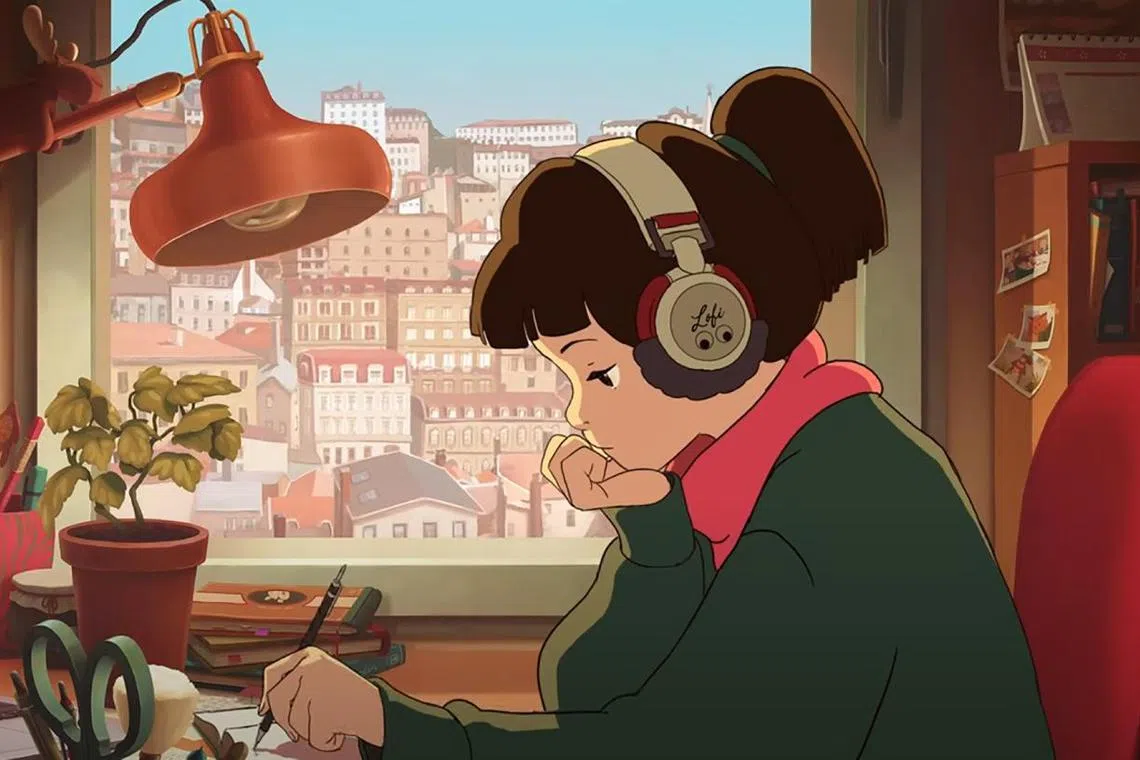
The most recognisable symbol of the genre, “lofi girl” has accumulated over 668 million views on a single multi-year live stream.
PHOTO: LOFI GIRL
Follow topic:
SINGAPORE – For many seeking a quiet atmosphere to study or work in, or those simply looking for refuge from the cacophony of daily life, one genre of music stands out.
Popularised by hours-long videos and playlists with titles like “lo-fi hip-hop radio beats to relax/study to” or “lo-fi coffee beats”, the lo-fi music genre has become an enduring staple on streaming platforms like YouTube and Spotify.
Lo-fi, short for “low fidelity,” is a genre that embraces imperfections in sound quality – and has drawn listeners with its soothing soundscapes that incorporate ambient noise, vinyl crackles and mellow instrumentals.
One such fan is Ms Regina Foo. The 18-year-old says: “Lo-fi is the only sort of music I can listen to without getting distracted while studying, so if I’m in a somewhat noisy place, it’s a lifesaver.”
With millions of listeners tuning in, the genre has ascended to heights of algorithmic popularity rarely seen with other types of music.
The most recognisable symbol of the genre, “lofi girl” – a YouTube channel featuring an animated girl studying to endless lo-fi beats – has accumulated over 668 million views on a single multi-year live stream.
Even Singapore’s National Day Parade tapped the trend, commissioning a lo-fi mix to celebrate the nation’s birthday in 2021.
Underlying the genre’s popularity is a fan base that finds solace and community within lo-fi playlists, with comments on YouTube’s lo-fi mixes often featuring heartfelt comments for other listeners.
One user writes: “Just wanna tell you that no matter how hopeless it seems now, you will see the light again at the end of the tunnel. It might be miles away, but it’s there and you will reach it. And you’re never alone on your way to it. Proud of you for coming this far.”
Another adds: “I wish the world was a lo-fi comment section.”
To delve deeper into this phenomenon and explore the reasons behind lo-fi’s appeal, The Straits Times speaks to Singapore’s own lo-fi creators and enthusiasts.
Meet Singapore’s bedroom producers
Many of the genre’s creators are “bedroom producers”, do-it-yourself musicians who compose and arrange their tracks from the comfort of their own homes.
For Dr Joshua Hoe, a 35-year-old cancer specialist, the Covid-19 pandemic was the catalyst for his entry into the genre.
“Being a cancer doctor isn’t the easiest job. It tends to feel like the world can be a pretty dark and cruel place, where bad things happen to good people, who get sick and die before their time,” he says.
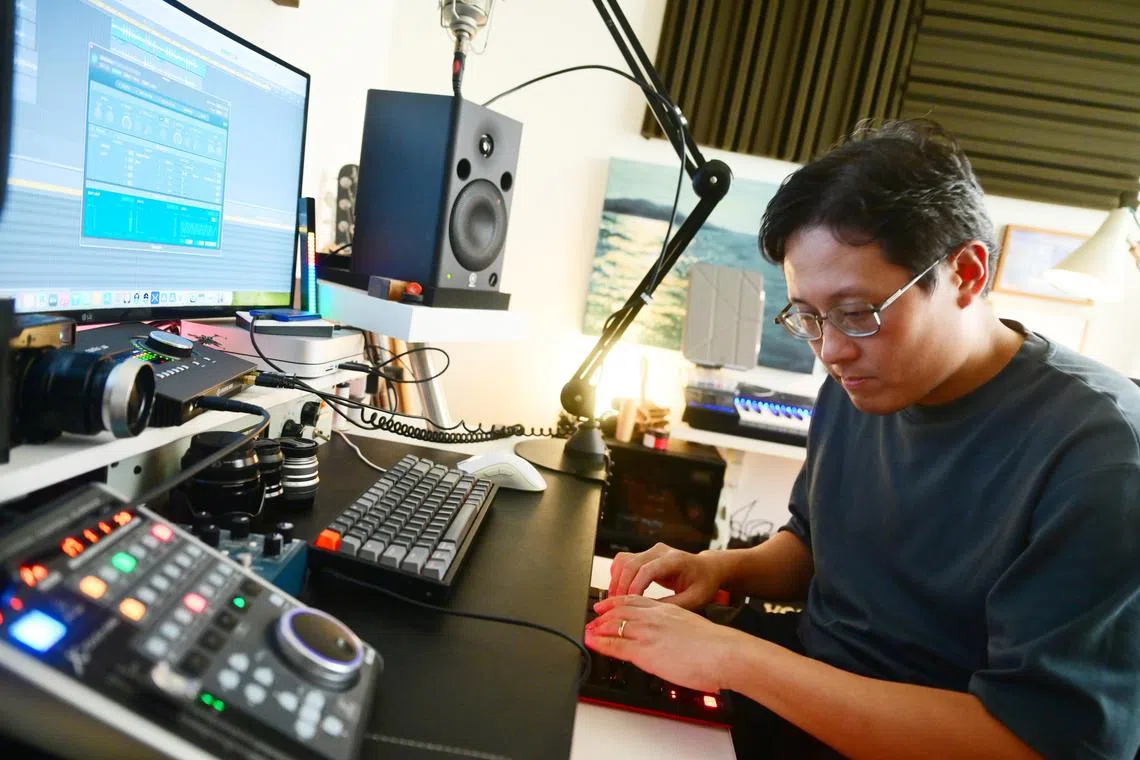
Doctor by day and lo-fi producer by night, Dr Joshua Hoe records and arranges his music from his own home.
ST PHOTO: AZMI ATHNI
Seeking an outlet, Dr Hoe turned to lo-fi music in 2021. The genre’s emphasis on mellow beats and simple arrangements made it a creative escape that was far less taxing than his day job.
Leveraging his long-time passion for playing the guitar, he began producing his own lo-fi tracks and distributing them through platforms like Jazz Hop Cafe, a record label and YouTube channel with more than one million subscribers.
Referring to the genre, Dr Hoe says: “It’s like your quiet friend. Your companion that accompanies you through difficult times.”
Similarly, 29-year-old freelance sound designer Amelia Sai – who splits her time between Singapore and Germany – discovered the genre during the pandemic as a home remedy for her insomnia.
“I have trouble sleeping. I tried sleeping pills and melatonin, and still couldn’t fall asleep,” she says. “Somehow, I stumbled on lo-fi music mixes through YouTube and Spotify and started using those to fall asleep.”
Frustrated by mixes that included overly harsh sounds that would wake her up mid-playlist, she decided to become a creator herself.
She says: “That’s when I decided I need to find out how to do it, so I can curate my own playlist.”
The genre’s focus on simplicity meant that picking it up was not difficult. She began watching video tutorials online about how to compose lo-fi music.
“Because people perceive it as background music, there’s a lower barrier to entry,” she says, adding that many of the creators she has encountered lack any professional background in music, and they also picked it up through a similar process.
This do-it-yourself and unpretentious ethos forms an essential part of the genre’s appeal, says Mr Dayn Ng, a programme leader in digital innovation at the Nanyang Academy of Fine Arts (Nafa). Not only does lo-fi make for easy listening, but the genre also lends itself to an easier production process.
“It is cheaper to produce as most tracks are instrumental with no additional recording or sampling of vocals required,” he adds.
“Creators can produce them with simple production set-ups, mix and master the tracks, eventually distributing them on streaming platforms with relative ease.”
The hidden economics of lo-fi sound
Lo-fi music, with its long unobtrusive mixes that blend seamlessly into the background, has proven to be an ideal match for the rise of streaming platforms. Algorithms designed to optimise user engagement frequently recommend lo-fi mixes because of how well they retain listeners.
This success has attracted record labels and companies aiming to capitalise on the genre’s unique algorithmic appeal.
A search on YouTube yields dozens of channels producing hours-long lo-fi videos, often with little discernible information about their creators.
Some channels even use identical, copy-pasted biographies and “about me” sections, merely swopping out the names of the supposed artists.
Ms Sai notes that these channels are sometimes operated by large companies which use a swarm of accounts to maximise engagement and revenue.
Referring to this disconnect between lo-fi music’s heartfelt embrace by listeners and the cold manipulation of streaming algorithms by certain channels, she says: “Yeah, it’s a bit disappointing, right?”
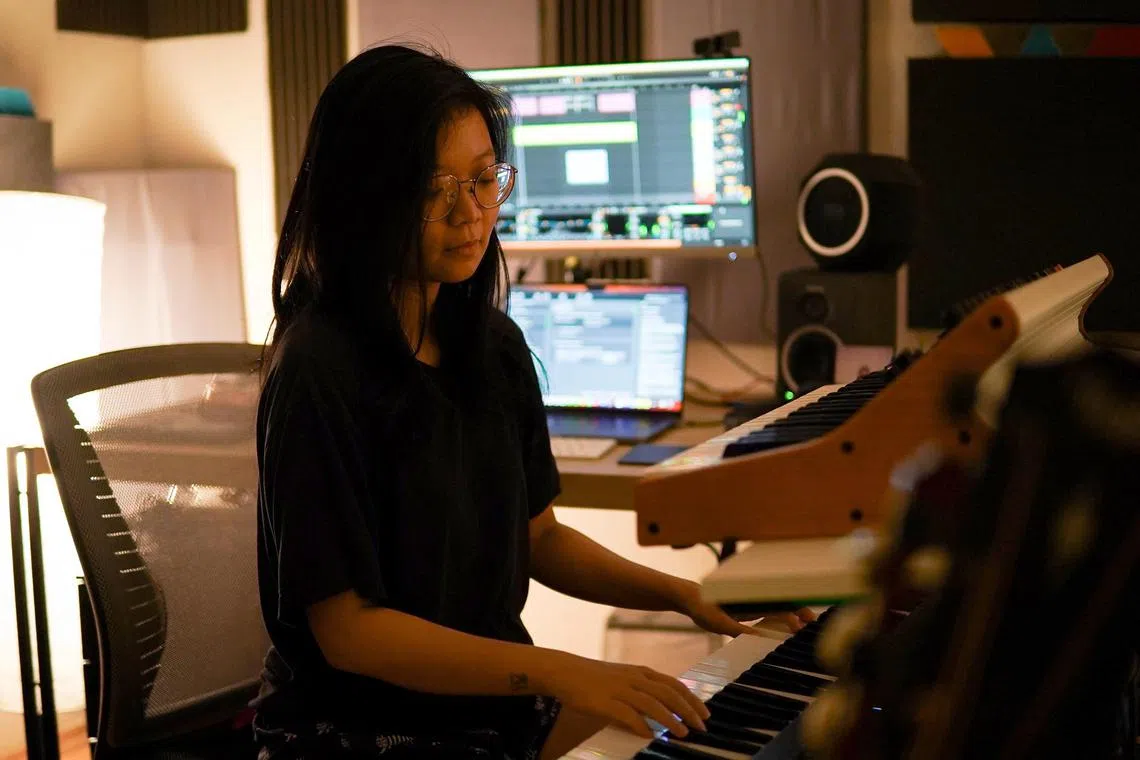
Ms Amelia Sai appreciates the solace that the lo-fi genre offers to listeners.
PHOTO: COURTESY OF AMELIA SAI
According to Mr Jack Brophy, director of Britain-based lo-fi record label Jazz Hop Cafe, the rise of such players has saturated the genre and made it more difficult for listeners to find quality music.
“Lo-fi peaked during the Covid-19 pandemic, but it was doing pretty well before then too,” Mr Brophy says. “Its further rise during the pandemic was great for the genre, but with it came many bad actors aiming to profit off the trending genre.”
He explains that although the vast majority of “poorly made” lo-fi videos being churned out daily by these channels do not garner many views, the rare viral hit is enough to make the exercise a profitable one.
Initially, when some of these groups reached out to Ms Sai to seek permission to use her songs as part of their hours-long mixes, she was heartened by the interest.
“But I realised these requests were coming in bulk – five to 10 requests each day across a ton of different channels. Then you realise they are owned by the same big company,” she says.
“After a while, I just stopped because it’s just too much,” she adds. “There are some channels where they indicate the artiste in the description, but some don’t even bother. Basically, they’re using your music without giving you anything.”
Not all creators face exploitation. Jazz Hop Cafe, which Dr Hoe works with to release his music, provides artists with a share of the streaming revenue while taking on distribution and promotion.
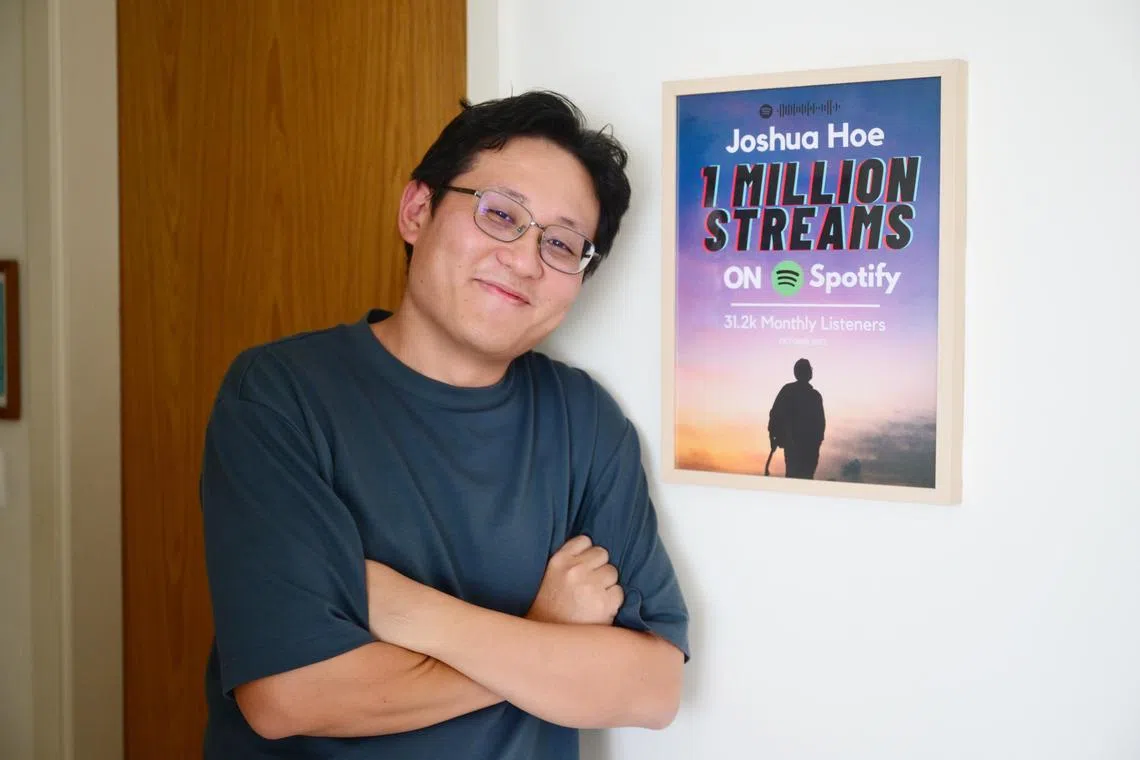
Dr Hoe with a poster made by his wife and sister celebrating his Spotify listenership.
ST PHOTO: AZMI ATHNI
And Ms Sai notes that different business models exist. She recalls encountering Vietnam-based creators who have been commissioned by companies to join their in-house roster and provide a set number of tracks in exchange for a share of the streaming revenue.
For the creators who spoke to ST, the genre remains a mixed bag when it comes to being a reliable source of income. Ms Sai and Dr Hoe say making lo-fi music remains a side hustle for them, rather than being their primary livelihood.
“I think streaming revenue models at the moment may not be the fairest to artists,” Dr Hoe says. “To even earn a sort of minimum standard of living for Singapore, you would need millions of streams a month.”
Ms Sai’s income from lo-fi music, which ranges from US$500 (S$640) to US$2,000 a month, stems from a mix of streaming revenue from her own music and from curating playlists on platforms like SubmitHub.
“I think I like the balance where it is now. Half of my income is from film and sound design, and the other half is from lo-fi music,” she says.
A genre based on imperfections
“One of the key aesthetics of lo-fi is its ‘noise’,” says Nafa’s Mr Ng. “Lo-fi’s qualities of saturation and imperfections contribute to a mellow sound with fewer high frequencies and a slightly slower tempo, almost like walking at a relaxed pace.”
He notes that much of lo-fi music is instrumental, lacking vocals or lyrics, which allows it to be played at a softer, ambient level where it blends into the background.
“This makes it ideal for accompanying a calm, soothing atmosphere – in other words, ‘chill vibes’,” he adds.
Mr Ng compares the effect of lo-fi music with that of white or pink noise – such as the sound of ocean waves – which can evoke a sense of calm and tranquillity.
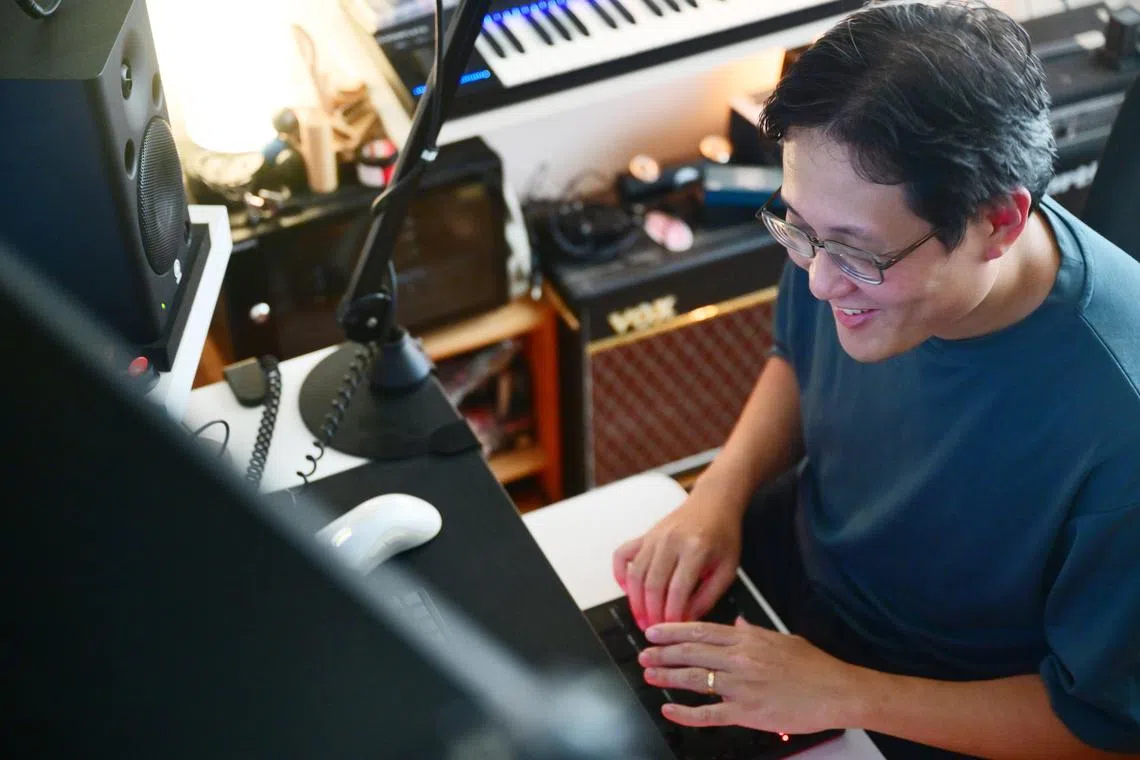
Dr Hoe says that thinking of the lo-fi genre purely as “elevator music” is an over-simplification.
ST PHOTO: AZMI ATHNI
Although lo-fi music’s embrace of simple arrangements and unpretentious sound has won millions of fans, it has also attracted critics who perceive it as lacking complexity.
Dr Hoe addresses this perception: “The nature of the genre is that it has to sit in this zone where it’s interesting enough but isn’t too over-the-top distracting, because that would defeat the point.”
As such, he adds, “the arrangements are a bit more stripped down”. Typical arrangements use only five to six main instruments, compared with the broader repertoire used in other genres.
Junior college student Tan Kang Le, 17, encountered the genre during the pandemic in 2020. He believes that it is a misconception that all lo-fi music is the same because of the genre’s simplicity.
Lo-fi music spans a wide spectrum of sound – varying based on whether it draws its influences more from jazz, blues, classical, rock, hip-hop or electronic music.
Kang Le – who has compiled a personal playlist of over 5,000 songs – prefers lo-fi music with a stronger rock influence, featuring more prominent rock themes, drums and varied tempos.
Jazz Hop Cafe’s Mr Brophy notes that lo-fi’s sound has evolved over the years, largely due to the commercialisation of the genre and the rise of record labels.
“When it started, lo-fi music was mostly composed of sample-based beats,” he says. “Because the music is tailored for background use, music channels and record labels became the forefront of the scene instead of the musicians being the main attraction like in other genres.
“As YouTube and digital streaming platforms became more strict about sample policies, many record labels started to accept only original compositions.
“This eventually filtered out the lazier producers and allowed the super talented producers to emerge. Today, lo-fi is mostly original compositions by multi-instrumentalist musicians.”
With society placing more emphasis on mental wellness, Mr Ng suggests that lo-fi music fits perfectly within current trends focused on mindfulness and relaxation.
“Things like sound therapy with healing bowls, deep sleep meditations and healing frequencies have become popular, and lo-fi provides an alternative avenue,” he says.
For creators such as Ms Sai, that her music offers solace to others like her is enough to justify delving deeper into the genre and making new arrangements.
She notes that her lo-fi videos often receive comments from netizens talking about their anxieties. “Users sometimes share how they feel depressed, even suicidal, and lo-fi music is a source of calm to them.
“I respond to every single comment on my videos,” she says. “Because it feels like someone is being so vulnerable with me in sharing so candidly about their lives.
“There are a lot of people who comment saying: ‘Know that you’re not alone.’ It’s really different from the way people comment on other music videos.”

